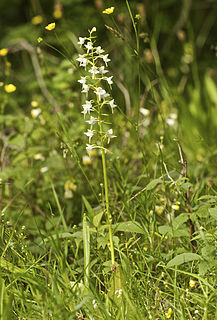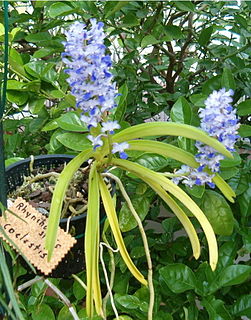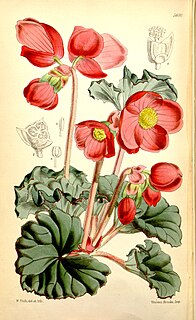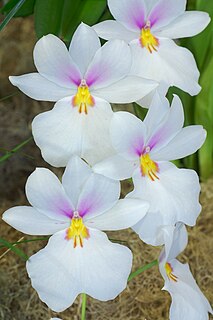
The Orchidaceae are a diverse and widespread family of flowering plants, with blooms that are often colourful and fragrant, commonly known as the orchid family.

Masdevallia, abbreviated Masd in horticultural trade, is a large genus of flowering plants of the Pleurothallidinae, a subtribe of the orchid family (Orchidaceae). There are over 500 species, grouped into several subgenera. The genus is named for Jose Masdeval, a physician and botanist in the court of Charles III of Spain.

Sir Harry James Veitch was an eminent English horticulturist in the nineteenth century, who was the head of the family nursery business, James Veitch & Sons, based in Chelsea, London. He was instrumental in establishing the Chelsea Flower Show, which led to him being knighted for services to horticulture.

Platanthera chlorantha, commonly known as greater butterfly-orchid, is a species of orchid in the genus Platanthera. It can be found throughout Europe and Morocco. The name Platanthera is derived from Greek, meaning "broad anthers", while the species name, chlorantha, means "green-flowered".

Rhynchostylis is a genus in the orchid family (Orchidaceae), closely allied to the genus Vanda and comprising four currently accepted species native to the Indian Subcontinent, China, Indochina, Malaysia, Indonesia and the Philippines. The name consists of a compound of two Greek elements : rhynchos 'beak' and stylis 'column' – in reference to the very broad, fleshy column of the flower. The flowers are borne in dense racemes and are noted for their intense, spicy fragrance. Although lacking in pseudobulbs, the plants have leathery leaves that are drought-resistant. These orchids grow naturally in warm, moist, shaded tropical areas and will thrive in cultivation if given consistent warmth, uniform moisture and bright, but indirect light. Hobbyists wanting to grow them will need a warm, humid growing environment with gentle air movement. They can be grown in pots, but are better grown in baskets, owing to the extreme fleshiness of their roots. Their unusually fragrant blooms often appear in the slightly cooler winter months.

Masdevallia veitchiana, also known as Veitch's masdevallia or king of the masdevallias, is an orchid species of the genus Masdevallia.

Gustav Wallis was a German plant collector, who introduced over 1,000 plant species to Europe, many of which were named after him.

Begonia veitchii is a plant in the begonia family, Begoniaceae, which was introduced to Europe in 1866 by Richard Pearce who discovered it in the Peruvian Andes near Cusco at an elevation of from 10,000 feet (3,000 m) and 12,000 feet (3,700 m). It was named after Pearce's employers, James Veitch & Sons of Chelsea, London. It can be found today in the mountains around Machu Picchu. A later plant collector, Walter Davis, found Begonia veitchii inhabiting rocky positions by waterfalls, in company with Masdevallia veitchiana.
Richard Pearce was a British plant collector, who introduced the tuberous begonia to England, which led to the development of the hybrid begonias grown today.

Masdevallia davisii, or Davis' masdevallia, is a species of the orchid genus Masdevallia. It is also known as the orchid of the sun and was known to the Incas as qoriwaqanki – due to its similarity in form to the red Masdevallia veitchiana, known as waqanki.
Walter Davis was an English plant collector, who collected in South America for James Veitch & Sons of Chelsea, London.

Miltoniopsis vexillaria is a species of epiphytic orchid in the genus Miltoniopsis.

Joseph Henry Chesterton was a British plant collector who was sent by James Veitch & Sons to search for orchids in South America with much success.

Odontoglossum crispum, the curled odontoglossum, is an epiphytic orchid from the genus Odontoglossum. It is considered by many to be the most beautiful orchid of all but is also one of the most difficult to grow.
Wilhelm (Guillermo) Kalbreyer (1847–1912) was a German plant collector who was sent by James Veitch & Sons of Chelsea, London to collect new plants in West Africa and South America.

William Lobb was a British plant collector, employed by Veitch Nurseries of Exeter, who was responsible for introducing to commercial growers Britain Araucaria araucana from Chile and the massive Sequoiadendron giganteum (Wellingtonia) from North America.

Masdevallia unguentum was discovered in 2010 in the collection of Finca Dracula and is reported from Colombia. It is morphologically similar to Masdevallia marthae which was also discovered in cultivation without collection data but was later re-discovered in 1993 on the road to a television tower in the Department of Risaralda, Colombia Both are members of the subsection Saltatrices which is characterized by flowers with a tubular calyx.

Dracula simia, called also monkey orchid or the monkey-like Dracula, is an epiphytic orchid originally described in the genus Masdevallia, but later moved to the genus Dracula. The arrangement of column, petals and lip strongly resembles a monkey's face. The plant blooms at any season with several flowers on the inflorescence that open successively. Flowers are fragrant with the scent of a ripe orange.

Tibouchina lepidota, also known as alstonville, Andean princess flower, lasiandra, or glory bush, is a medium-sized ornamental tree or a large shrub native to northwestern South America that is cultivated for its masses of purple flowers from autumn right through to winter.
















